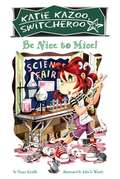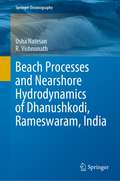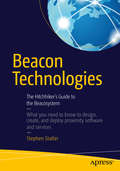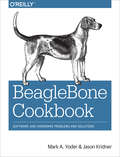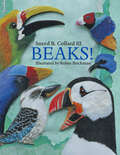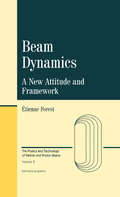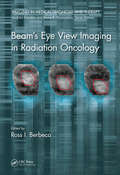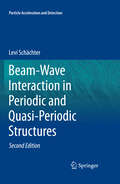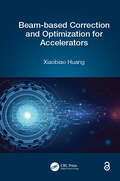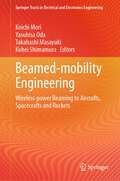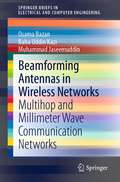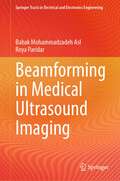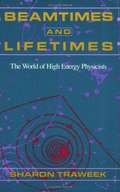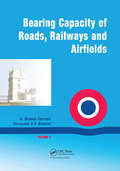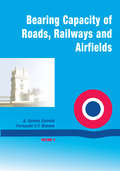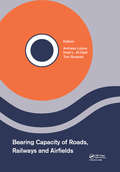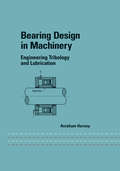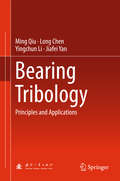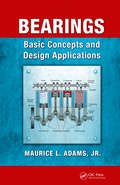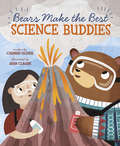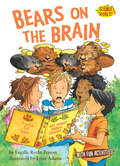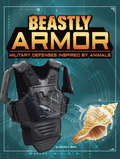- Table View
- List View
Be Nice to Mice! (Katie Kazoo Switcheroo #20)
by Nancy KrulikFourth-grader Katie is concerned when an older girl uses live mice in a science fair project, but when Katie turns into the sixth-grader and has to run the experiment herself, she has a different opinion of the student.
Be Your Own House Contractor: Save 25% without Lifting a Hammer
by Carl HeldmannYou don’t need to depend on (or pay) a general contractor to manage your construction project. Whether you’re building a new home or renovating an existing one, you can manage the job yourself. <P><P>Carl Heldmann outlines how to purchase your own land, set a reasonable budget and schedule, describe your needs and vision to an architect, and hire subcontractors to do the actual building. Cut out the middleman and save as much as 25 percent on your beautiful new home!
Be an InventHer: An Everywoman's Guide to Creating the Next Big Thing
by Mina Yoo Hilary MeyersonBe an InventHER is a complete guide to inventing, geared toward any woman who wants to bring her invention, innovation, or creation from idea to the marketplace.Authors Mina Yoo and Hilary Meyerson offer practical advice to any woman looking to take an invention from idea to market. Walking you through the entire process, they offer encouragement, success stories of other female inventors, and concrete guidance to help readers realize their dreams of invention. Inventing and innovation is a hot topic, and this book--coauthored by a woman who created a successful business that started as a sketch on a cocktail napkin--offers a helping hand through the invention process without intimidation or undue complication.
Beach Processes and Nearshore Hydrodynamics of Dhanushkodi, Rameswaram, India (Springer Oceanography)
by Usha Natesan R. VishnunathThis book focuses on understanding the shoreline dynamics, nearshore processes and sediment transport around Rameswaram Island and the cities of Dhanushkodi and Arichamunai. Rameswaram Island is located between the Gulf of Mannar on the south and Palk Bay on the north, between the southern tip of India and Sri Lanka, and is unique in terms of physical, chemical and biological processes. The Gulf of Mannar is established as a marine biodiversity conservation area by its richness of variety and variability of marine species such as corals, finfish, shellfish and other fishes. The island is predominantly influenced by four seasons: northeast monsoon, post-monsoon, summer and southwest monsoon; and the sedimentological and hydrodynamic conditions significantly change seasonally, resulting in the island’s responding in a different manner with each season. It also explains the physical forces and their impacts around these areas. Rameswaram Island has existed naturally for a long period of time even under the influence of different water masses of the Gulf of Mannar and Palk Bay. Understanding the regional natural phenomena is the only solution to carry out the best management practices to develop coastal constructions and modifications.
Beacon Technologies: The Hitchhiker's Guide to the Beacosystem
by Stephen StatlerLearn the key standards--iBeacon, Eddystone, Bluetooth 4. 0, and AltBeacon--and how they work with other proximity technologies. Then build your understanding of the proximity framework and how to identify and deploy the best solutions for your own business, institutional, or consulting needs. Proximity technology--in particular, Bluetooth beacons--is a major source of business opportunity, and this book provides everything you need to know to architect a solution to capitalize on that opportunity. What You'll Learn Understand the disruptive implications of digital-physical convergence and the new applications it makes possible Review the key standards that solutions developers need to understand to capitalize on the business opportunity of proximity technology Discover the new phenomenon of beacon networks, which will be hugely significant in driving strategic decisions and creating wealth See other technologies in the proximity ecosystem catalyzed by and complementary to Bluetooth beacons, including visual light communication, magnetic resonance, and RFID Examine the Beacosystem framework for analyzing the proximity ecosystem Who This Book Is For Solutions architects of all types--venture capitalists, founders, CEOs, strategists, product managers, CTOs, business developers, and programmers Stephen Statler is a writer, public speaker, and consultant working in the beacon ecosystem. He trains and advises retailers, venue owners, VCs, as well as makers of beacon software and hardware, and is a thought leader in the beacosystem community. Previously he was the Senior Director for Strategy and Solutions Management at Qualcomm's Retail Solutions Division, helping to incubate Gimbal, one of the leading Bluetooth beacons in the market. He is also the CEO of Cause Based Solutions, creators of Give the Change, democratizing philanthropy, enabling non-profit supporters to donate the change from charity branded debit cards, and developer of The Good Traveler program. Contributors: Anke Audenaert, CEO, Favrit John Coombs, CEO, Rover Labs Theresa Mary Gordon, Co-Founder, tapGOconnect Phil Hendrix, Director, immr Kris Kolodziej, President, IndoorLBS Patrick Leddy, CEO, Pulsate Ben Parker, VP Business Development, AccelerateIT Mario Proietti, CEO, Location Smart Ray Rotolo, SVP OOH, Gimbal Kjartan Slette, COO, Unacast Jarno Vanto, Partner, Borenius Attorneys LLP David Young, Chief Engineer, Radius Networks Foreword by Asif Khan, President LBMA
BeagleBone Cookbook: Software and Hardware Problems and Solutions
by Mark A. Yoder Jason KridnerBeagleBone is an inexpensive web server, Linux desktop, and electronics hub that includes all the tools you need to create your own projects—whether it’s robotics, gaming, drones, or software-defined radio. If you’re new to BeagleBone Black, or want to explore more of its capabilities, this cookbook provides scores of recipes for connecting and talking to the physical world with this credit-card-sized computer.All you need is minimal familiarity with computer programming and electronics. Each recipe includes clear and simple wiring diagrams and example code to get you started. If you don’t know what BeagleBone Black is, you might decide to get one after scanning these recipes.Learn how to use BeagleBone to interact with the physical worldConnect force, light, and distance sensorsSpin servo motors, stepper motors, and DC motorsFlash single LEDs, strings of LEDs, and matrices of LEDsManage real-time input/output (I/O)Work at the Linux I/O level with shell commands, Python, and CCompile and install Linux kernelsWork at a high level with JavaScript and the BoneScript libraryExpand BeagleBone’s functionality by adding capesExplore the Internet of Things
Beaks!
by Sneed B. CollardHow can a toucan fly with such a large, cumbersome beak? A toucan's beak is actually light as a feather due to its honeycomb construction. And not only is it beautiful, but it's an extremely useful tool in foraging for food. Find out more fascinating facts in this remarkably illustrated study of bird beaks. Learn about several different birds, their habitats, and how their beaks are uniquely styled to help them survive. Outstanding 3-D cut-paper illustrations by Robin Brickman create amazingly realistic tableaus of birds in their natural environments with their beaks in action. Back matter includes a comprehensive quiz, a bibliography, and a list of related Web sites.
Beam Dynamics
by Etienne ForestThis volume lays down the foundations of a theory of rings based on finite maps. The purpose of the ring is entirely discussed in terms of the global properties of the one-turn map. Proposing a theory of rings based on such maps, this work offers another perspective on storage ring theory.
Beam's Eye View Imaging in Radiation Oncology (Imaging in Medical Diagnosis and Therapy)
by Ross I. BerbecoThis first dedicated overview for beam’s eye view (BEV) covers instrumentation, methods, and clinical use of this exciting technology, which enables real-time anatomical imaging. It highlights how the information collected (e.g., the shape and size of the beam aperture and intensity of the beam) is used in the clinic for treatment verification, adaptive radiotherapy, and in-treatment interventions. The chapters cover detector construction and components, common imaging procedures, and state of the art applications. The reader will also be presented with emerging innovations, including target modifications, real-time tracking, reconstructing delivered dose, and in vivo portal dosimetry. Ross I. Berbeco, PhD, is a board-certified medical physicist and Associate Professor of Radiation Oncology at the Dana-Farber Cancer Institute, Brigham and Women’s Hospital and Harvard Medical School.
Beam-Wave Interaction in Periodic and Quasi-Periodic Structures: Beam-wave Interaction In Periodic And Quasi-periodic Structures (Particle Acceleration and Detection)
by Levi SchächterThe main theme of this book is the interaction of electrons with electromagnetic waves in the presence of periodic and quasi-periodic structures in vacuum, in view of applications in the design and operation of particle accelerators. The first part of the book is concerned with the textbook-like presentation of the basic material, in particular reviewing elementary electromagnetic phenomena and electron dynamics. The second part of the book describes the current models for beam-wave interactions with periodic and quasi-periodic structures. This is the basis for introducing, in the last part of the book, a number of particle and radiation sources that rest on these principles, in particular the free-electron laser, wake-field acceleration schemes and a number of other advanced particle accelerator concepts. This second edition brings this fundamental text up-to-date in view of the enormous advances that have been made over the last decade since the first edition was published. All chapters, as well as the bibliography, have been significantly revised and extended, and the number of end-of-chapter exercises has been further increased to enhance this book's usefulness for teaching specialized graduate courses.
Beam-based Correction and Optimization for Accelerators
by Xiaobiao HuangThis book provides systematic coverage of the beam-based techniques that accelerator physicists use to improve the performance of large particle accelerators, including synchrotrons and linacs. It begins by discussing the basic principles of accelerators, before exploring the various error sources in accelerators and their impact on the machine's performances. The book then demonstrates the latest developments of beam-based correction techniques that can be used to address such errors and covers the new and expanding area of beam-based optimization. This book is an ideal, accessible reference book for physicists working on accelerator design and operation, and for postgraduate studying accelerator physics. Features: Entirely self-contained, exploring the theoretic background, including algorithm descriptions, and providing application guidance Accompanied by source codes of the main algorithms and sample codes online Uses real-life accelerator problems to illustrate principles, enabling readers to apply techniques to their own problems Xiaobiao Huang is an accelerator physicist at the SLAC National Accelerator Laboratory at Stanford University, USA. He graduated from Tsinghua University with a Bachelor of Science in Physics and a Bachelor of Engineering in Computer Science in 1999. He earned a PhD in Accelerator Physics from Indiana University, Bloomington, Indiana, USA, in 2005. He spent three years on thesis research work at Fermi National Accelerator Laboratory from 2003-2005. He has worked at SLAC as a staff scientist since 2006. He became Accelerator Physics Group Leader of the SPEAR3 Division, Accelerator Directorate in 2015. His research work in accelerator physics ranges from beam dynamics, accelerator design, and accelerator modelling and simulation to beam based measurements, accelerator control, and accelerator optimization. He has taught several courses at US Particle Accelerator School (USPAS), including Beam Based Diagnostics, Accelerator Physics, Advanced Accelerator Physics, and Special Topics in Accelerator Physics.
Beamed-mobility Engineering: Wireless-power Beaming to Aircrafts, Spacecrafts and Rockets (Springer Tracts in Electrical and Electronics Engineering)
by Koichi Mori Yasuhisa Oda Takahashi Masayuki Kohei ShimamuraThis book describes the technologies of wireless power beaming to the aerospace crafts, such as the drone, flying car, aircraft, spacecraft, and rocket. Using a highly directional electromagnetic wave beam, energy is remotely supplied to mobility that moves at high speed without waste, and it is efficiently converted into the driving force of mobility. This technology will be indispensable for the full electrification of mobility in the future. This book specializes in aerospace mobility, where weight and other constraints are strict, and was written by researchers in different disciplines such as rocket engineering, plasma engineering, laser engineering, and communications and control engineering. Beamed-mobility forms a new area of integrated engineering. The new combination of optics and mechanical engineering creates a world where mobility is free to supply the energy needed for propulsion, wherever and wherever it goes. It is expected to become the core technology of mobility, energy, infrastructure, and services of the future society that extends to outer space. This book will serve as a good reference for graduate students, researchers, and professional engineers in the field of aerospace, electrical, and mechanical engineering.
Beamforming Antennas in Wireless Networks: Multihop And Millimeter Wave Communication Networks (Springerbriefs In Electrical And Computer Engineering Ser.)
by Osama Bazan Baha Uddin Kazi Muhammad JaseemuddinWireless networks are facing growing demand for high capacity, better coverage, support of new applications and broad range of services. In this book, the authors first present an overview of beamforming antennas and millimeter wave communications followed by a discussion on the challenges and issues facing MAC and multi-hop routing in the wireless networks with beamforming antennas. Then, they discuss various MAC and routing protocols that are specifically designed to address those issues and exploit the benefits of millimeter wave and beamforming antennas. Authors also present a framework to provide Quality of Service (QoS) in contention-based wireless networks with beamforming antennas. Finally, the book is concluded with a discussion on open research topics for future generation WLAN systems.
Beamforming in Medical Ultrasound Imaging (Springer Tracts in Electrical and Electronics Engineering)
by Babak Mohammadzadeh Asl Roya ParidarThis book deals with the concept of medical ultrasound imaging and discusses array signal processing in ultrasound. Signal processing using different beamforming techniques in order to achieve a desirable reconstructed image and, consequently, obtain useful information about the imaging medium is the main focus of this book. In this regard, the principles of image reconstruction techniques in ultrasound imaging are fully described, and the required processing steps are completely expanded and analyzed in detail. Simulation results to compare the performance of different beamformers are also included in this book to visualize their differences to the reader. Other advanced techniques in the field of medical ultrasound data processing, as well as their corresponding recent achievements, are also presented in this book. Simply put, in this book, processing of medical ultrasound data from different aspects and acquiring information from them in different manners are covered and organized in different chapters. Before going through the detailed explanation in each chapter, it gives the reader an overview of the considered issue and focuses his\her mind on the challenge ahead. The contents of the book are also presented in such a way that they are easy for the reader to understand. This book is recommended for researchers who study medical ultrasound data processing.
Beamtimes and Lifetimes: The World of High Energy Physicists
by Sharon TraweekThe unique breed of particle physicists constitutes a community of sophisticated mythmakers--explicators of the nature of matter who forever alter our views of space and time. But who are these people? What is their world really like? Sharon Traweek, a bold and original observer of culture, opens the door to this unusual domain and offers us a glimpse into the inner sanctum.
Bear Wrangler: Memoirs of an Alaska Pioneer Biologist
by Will TroyerBeginning in 1951, Will Troyer embarked on a thirty-year career with the U.S. Department of the Interior that included positions such as fish and game warden and manager of the Kodiak Island brown bear preserve. Troyer’s engaging prose affirms his passionate connection to the natural world, as he describes experiences such as being in the midst of a herd of 40,000 caribou. Bear Wrangler is an absorbing tale of one man’s experience as an authentic pioneer in the last vestiges of American wilderness.
Bearing Capacity Of Roads Volume 1
by A. Gomes CorreiaThis book is an outcome of the sixth conference on bearing capacity of roads and airfield held in Lisbon, Portugal. It focuses on railway tracks and covers following topics: bearing capacity policies, concepts, costs and condition surveys; analysis and modelling; design and environmental effects.
Bearing Capacity Of Roads Volume 2
by A. Gomes CorreiaThis book is an outcome of the sixth conference on bearing capacity of roads and airfield held in Lisbon, Portugal. It covers the following topics: bearing capacity policies, concepts, costs and condition surveys; analysis and modelling; design and environmental effects; and asphalt mixtures.
Bearing Capacity of Roads, Railways and Airfields: Proceedings of the 10th International Conference on the Bearing Capacity of Roads, Railways and Airfields (BCRRA 2017), June 28-30, 2017, Athens, Greece
by Andreas Loizos Imad Al-Qadi Tom ScarpasBearing Capacity of Roads, Railways and Airfields includes the contributions to the 10th International Conference on the Bearing Capacity of Roads, Railways and Airfields (BCRRA 2017, 28-30 June 2017, Athens, Greece). The papers cover aspects related to materials, laboratory testing, design, construction, maintenance and management systems of transport infrastructure, and focus on roads, railways and airfields. Additional aspects that concern new materials and characterization, alternative rehabilitation techniques, technological advances as well as pavement and railway track substructure sustainability are included. The contributions discuss new concepts and innovative solutions, and are concentrated but not limited on the following topics: · Unbound aggregate materials and soil properties· Bound materials characteritics, mechanical properties and testing· Effect of traffic loading· In-situ measurements techniques and monitoring· Structural evaluation· Pavement serviceability condition· Rehabilitation and maintenance issues· Geophysical assessment· Stabilization and reinforcement· Performance modeling· Environmental challenges· Life cycle assessment and sustainability Bearing Capacity of Roads, Railways and Airfields is essential reading for academics and professionals involved or interested in transport infrastructure systems, in particular roads, railways and airfields.
Bearing Design in Machinery: Engineering Tribology and Lubrication (Mechanical Engineering Ser. #Vol. 147)
by Avraham HarnoyCovering the fundamental principles of bearing selection, design, and tribology, this book discusses basic physical principles of bearing selection, lubrication, design computations, advanced bearings materials, arrangement, housing, and seals, as well as recent developments in bearings for high-speed aircraft engines. The author explores unique so
Bearing Tribology: Principles and Applications
by Ming Qiu Long Chen Yingchun Li Jiafei YanBy focusing on the theory and techniques of tribological design and testing for bearings, this book systematically reviews the latest advances in applications for this field. It describes advanced tribological design, theory and methods, and provides practical technical references for investments in bearing design and manufacturing. The theories, methods and cases in this book are largely derived from the practical engineering experience gained and research conducted by the author and her team since the 2000s. The book includes academic papers, technical reports and patent literature, and offers a valuable guide for engineers involved in bearing design.
Bearings: Basic Concepts and Design Applications
by Maurice L. AdamsBearings: from Technoloogical Foundations to Practical Design Applications provides a modern study of bearing types, design factors, and industrial examples. The major classes of bearings are described, and design concepts are covered for rolling elements, surfaces, pivots, flexures, and compliance surfaces. Fluid film lubrication is presented, and the basics of tribology for bearings is explained. The book also looks at specific applications of bearing technology, including bearings in vehicles, rotating machinery, machine tools, and home appliances. Case studies are also included.
Bears Make the Best Science Buddies
by Carmen OliverIt's time for the first science lab, and nobody can agree on an experiment. But why pick just one when Bear is around? Bears makes the best science buddies, and Bear proves it by helping each group use the scientific method for its special experiment. This fourth picture book in Carmen Oliver's Bears Make the Best...series will bring the excitement of science to a new level.
Bears on the Brain (Science Solves It!)
by Lucille Recht PennerSolve kid-sized dilemmas and mysteries with the Science Solves It! series. These fun science books for kids ages 5–8 blend clever stories with real-life science. Why did the dog turn green? Can you control a hiccup? Is that a UFO? Find the answers to these questions and more as kid characters dive into physical, life, and earth sciences. What made the mysterious tracks in Oscar's yard? Oscar insists it's a bear. The kids devise a plan to get a clear set of prints and compare them to the pictures they find at the library. Will they solve the mystery? Books in this perfect STEM series will help kids think like scientists and get ahead in the classroom. Activities and experiments are included in every book! (Level One; Science topic: Animal Tracks)
Beastly Armor: Military Defenses Inspired by Animals (Beasts and the Battlefield)
by Charles C. HoferThe world can be a dangerous place. Over time, animals evolved many natural defenses to help them survive. Combat during wartime is extremely dangerous. Why not look to nature to find the best defenses for soldiers on the battlefield? Military forces have done just that for hundreds of years. From the armor of medieval knights to tomorrow's advanced camouflage, take a look at how military technology often mimics the traits of animals to help protect soldiers in combat. Then be sure to catch the other amazing titles in the Beasts and the Battlefield series.
